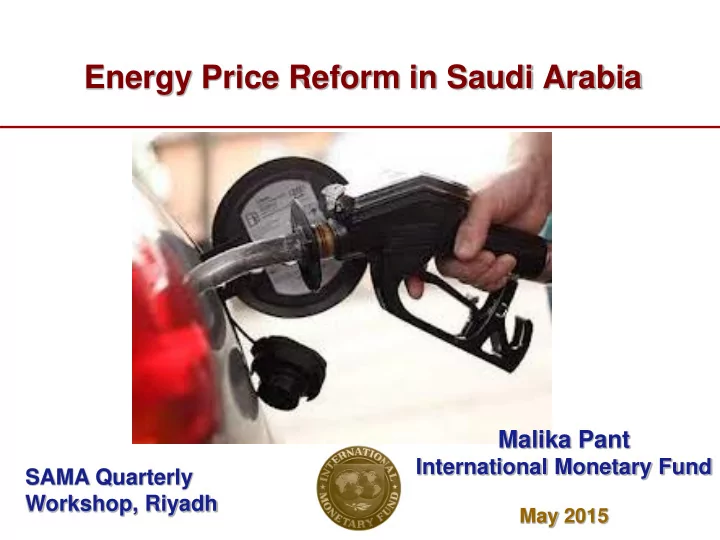

Energy Price Reform in Saudi Arabia Malika Pant International Monetary Fund SAMA Quarterly Workshop, Riyadh May 2015
Overview Low domestic energy prices entail substantial cost: Rapid growth in domestic consumption Foregone export revenues are high Disproportionately benefit higher-income groups Cross country experiences suggest comprehensive energy price reform plans needed 2
Saudi Arabia has one of the lowest energy prices in the world Gasoline prices in 2014 1.0 United states - pre-tax 0.8 0.6 0.4 GCC average 0.2 0.0 Saudi Bahrain Qatar Kuwait Algeria Oman Iraq Iran U.A.E. Arabia 3
… which suggests high implicit cost of low energy prices Implied Energy Cost for Saudi Arabia in 2014 5
Per capita domestic consumption is high Energy Consumption vs. Price of Gasoline 120 Annual Energy Consumption Per Capita, 2010 Median Qatar 100 Singapore (barrel of oil equiv.) UAE 80 Kuwait Canada Norway 60 Oman USA Saudi Arabia 40 Russia Turkmenistan Median Germany Kazakhstan 20 UK Iran Malaysia South Africa Algeria China Venezuela Turkey Mexico Brazil Indonesia Egypt Ecuador India 0 0 0.5 1 1.5 2 2.5 3 Price of Gasoline, end-2010 (US$ per liter) Sources: BP statistical review 2010, Country authorities, Gasoline prices GTZ online data and Fund staff calculations. 6
Low energy prices have promoted energy intensive industries High Energy-Intensive Exports and Gasoline Price, 2011 1 7
High energy consumption crowds out exports Saudi Arabia: Trends in Oil Consumption and Exports ( in percent change) At current rate of consumption growth: • Additional future demand could crowd out refined exports by 2021. • By 2040, 8.4 mbd of oil would be consumed domestically (equivalent to current exports). 2
Energy price reforms could help retain priority spending during fiscal adjustment Saudi Arabia: Government Expenditure and Implicit Fuel Cost (SAR billion) 500 Estimated Implicit fuel cost (oil and gas) 450 Compensation of employees 400 Other current expenses 350 Capital expenditure 300 250 200 150 100 50 0 2010 2011 2012 2013 2014 2015 proj. Sources: Country authorities and IMF staff estimates. 2
International experience: low energy prices disproportionately benefit the better-off • The leakages are more pronounced for low prices for gasoline Share of Energy Subsidies Benefiting the Bottom 40 and diesel . Percent of the Population 1 (Direct Effect) • In Egypt, the poorest 40 percent of the population received only 3 percent of benefits from low gasoline prices, 7 and 10 percent in case of natural gas and diesel respectively. 9
In Saudi Arabia, energy price reforms would likely impact richer households (HHs) • Richer HHs spend a higher share on transport related expenses than other HHs • Richer HHs spend lower share on utilities than other HHs Percent share of average monthly expenditure of households Utilities Transport Description Total -weighted avg. 2.2% 9.1% greater than 25000 1.2% 13.0% Above average spending 15000-24999 2.2% 9.6% households 9000-14999 2.7% 6.7% 3000-8999 3.1% 5.1% Low to medium spending 2000-2999 4.1% 3.1% households 1500-1999 4.6% 2.1% 1000-1499 4.5% 1.5% less than 1000 4.0% 1.2% 2 Source: CDSI, Household survey, 2013.
Current planned reforms include supply and demand side measures Supply side measures: Increase refining capacity Increase electricity generation capacity Develop the Public transport system Demand side measures: Energy Efficiency Low energy price would skew the cost-benefit calculation and create barriers 2
Key Strategies • Comprehensive energy sector reform plan • Well-planned and comprehensive communication strategy • Appropriately phased and sequenced price increases • Depoliticized price setting and adopting an automatic price mechanism Example of success: Jordan (2012), Morocco (2014) 2
Key Strategies • Targeted Mitigating measures Improving Targeting Cash Transfers Households & Productive sector 2
Impact • Impact on domestic inflation • Country experiences differ • Limited impact if reform is well planned and gradual • First round effects • Second round effects • Impact on the productive sector • Increase production costs for industries • Shift in production mix away from energy intensive goods • Introduce mitigating measures • Improving the business climate 2
Key takeaways for Saudi Arabia • Cost of low energy prices are substantial • Need for a comprehensive Energy Price Reform Plan • Availability of detailed household and industrial level data for incidence analysis. 2
Thank you!
Recommend
More recommend